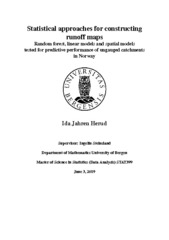| dc.description.abstract | In this thesis we study statistical approaches to tackle predictions of ungauged catchments in Norway. In collaboration with Norwegian Water Resources and Energy Directorate (NVE) we use observations of runoff, catchment characteristics (e.g. elevation and land use) and observations of precipitation for constructing runoff models suitable for runoff maps. The challenge of constructing suitable models for ungauged catchments is due to the lack of observations, and in the field of hydrology this problem is known as the problem of ungauged basins (Blöschl et al., 2013). It is common to either use a deterministic hydrological model or asuitable model for transferring observations from a gauged catchment to an ungauged catchment. Our statistical approach for modeling median annual runoff has been done in a three-step procedure where our main focus has been on the models predictive performance also including the uncertainty quantification. First, we did an exploratory analysis of observed median annual runoff and catchment characteristics. As a second step we fitted two initial model classes (linear regression models and random forests models) where we observed how the different explanatory variables/features influenced our predictions. With the main learning’s of our second step we built four different spatial models within the Bayesian framework. From the main learning’s we found that spatial dependency have a large effect on predictive performance, and that gradient basin was the only catchment characteristics that influenced the models. The model with the best predictive performance was a Bayesian hierarchical model of tree levels where gradient basin was included in addition to a Gaussian random field (GRF) and precipitation with a spatially varying coefficient. All models have been carefully evaluated through leave-one-out cross-validation (LOOCV), where each model have been evaluated in terms of predictive performance with the two evaluation metrics; root mean square error (RMSE) and continuous ranked probability score (CRPS). While RMSE describes the difference between observed and predicted runoff, we account for the whole posterior predictive distribution with CPRS, and is thus useful for quantifying the uncertainty of our predictions. | en_US |
